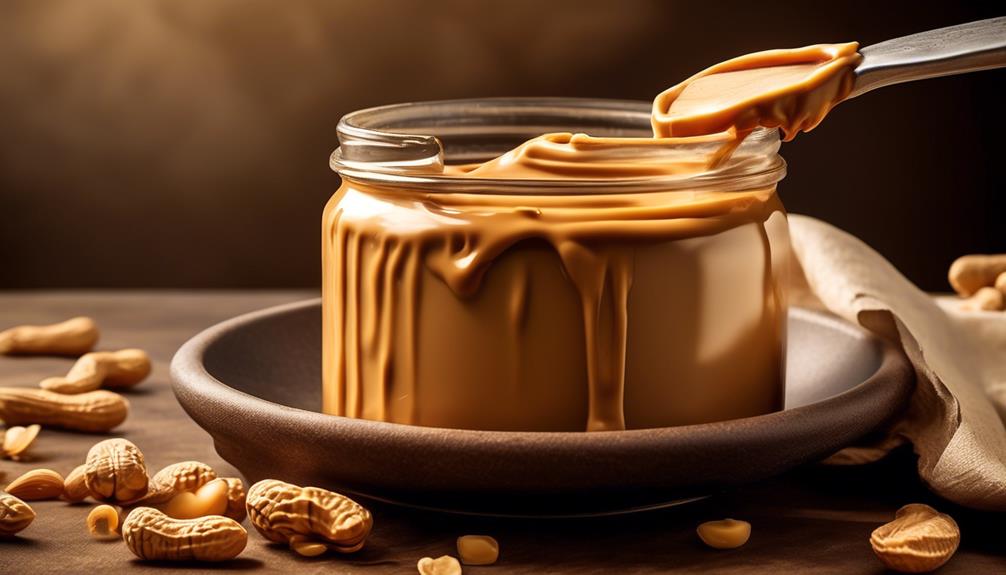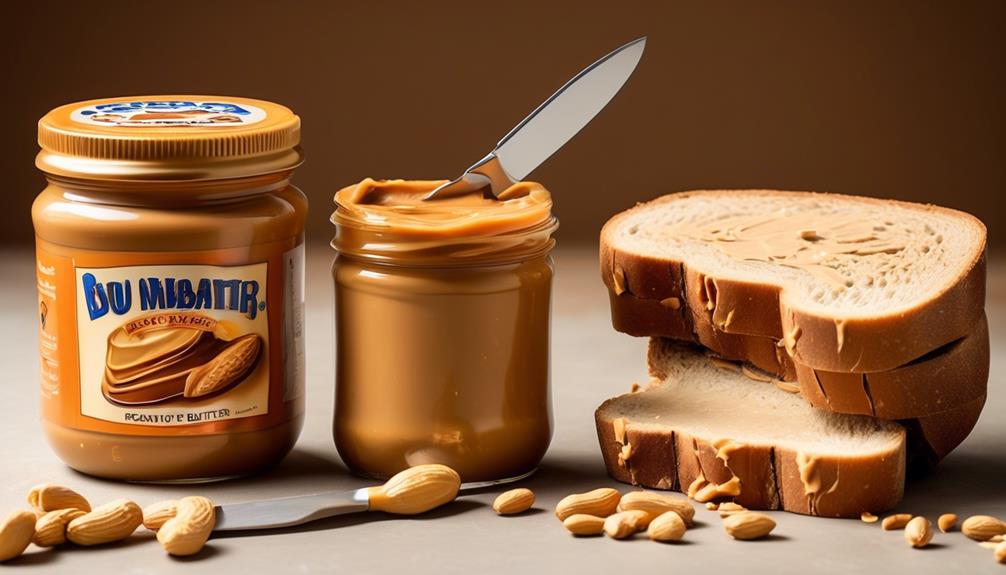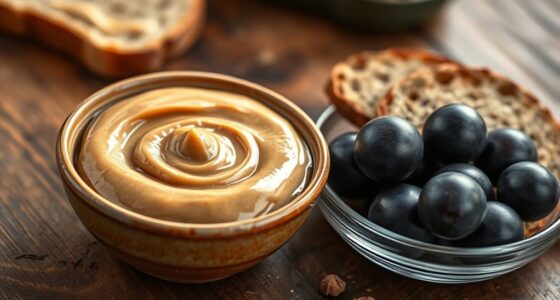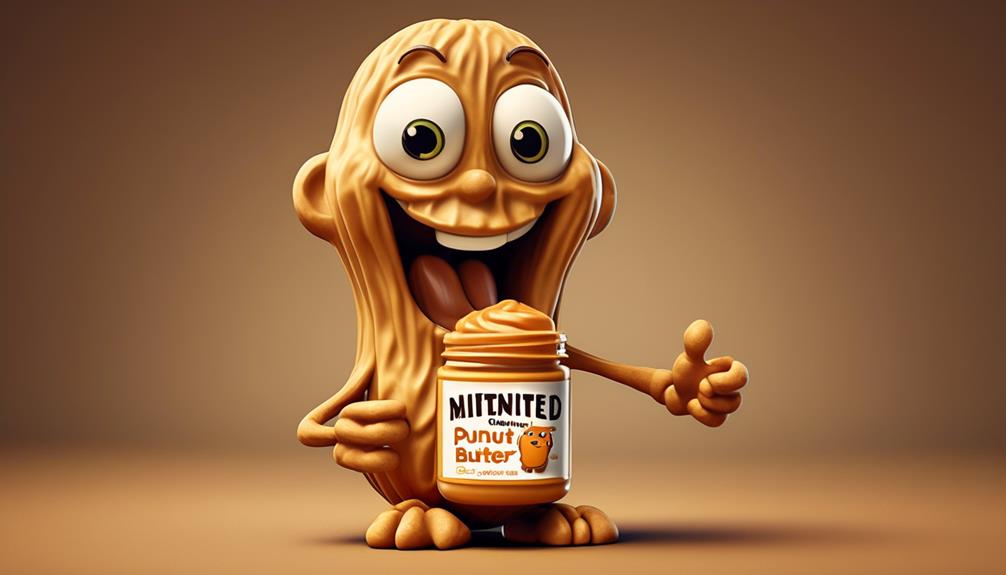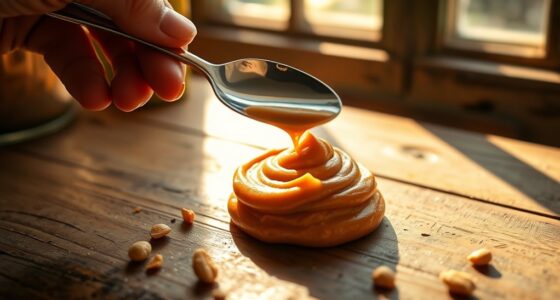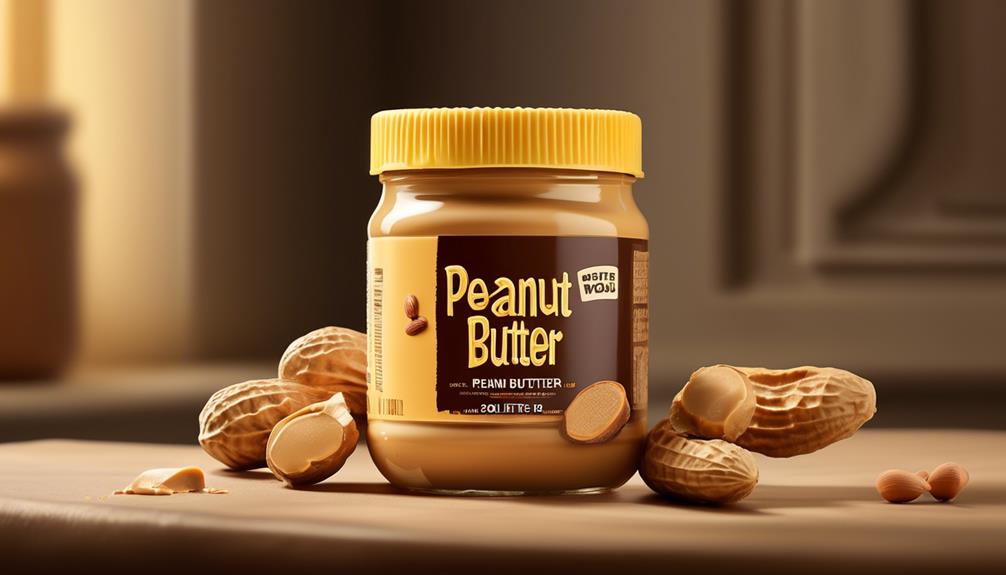We have all experienced the annoying problem of oily peanut butter – that thin layer of oil floating on top of our favorite spread.
But fear not, there are a few simple solutions to tackle this slippery situation. By employing a few clever techniques and tools, we can transform our oily peanut butter into a perfectly creamy and spreadable delight.
So, if you're tired of struggling with separated peanut butter, stick around to discover the secrets to fixing this common kitchen conundrum.
Key Takeaways
- Natural peanut butter lacks stabilizers, causing oil separation from the peanut solids.
- Storing techniques such as storing upside down and refrigeration can help prevent oil separation.
- Blending techniques using a peanut butter lid mixer, hand mixer, or immersion blender can re-emulsify separated peanut butter.
- Adding absorbent ingredients like powdered milk, flour, oats, chia seeds, or ground flaxseed can reduce oiliness and achieve the desired consistency.
Why Does Peanut Butter Get Oily?
Natural peanut butter becomes oily due to the absence of stabilizers, which causes the oil to separate from the peanut solids. Unlike commercial peanut butter, natural peanut butter contains just two ingredients – peanuts and salt. The absence of stabilizers, such as hydrogenated oils, in natural peanut butter allows the oil to naturally separate from the peanut solids. This can result in a layer of oil on top of the butter, making it necessary to stir the contents thoroughly before use.
This phenomenon isn't limited to peanut butter alone. Almond butter, another popular nut butter, also experiences oil separation for the same reason. The lack of stabilizers in almond butter permits the natural oils from the almonds to separate and form a layer on the top of the jar.
To address this issue, some people resort to using a hand mixer to thoroughly blend the oil back into the peanut or almond butter. However, it's essential to do this carefully to avoid making a mess. Understanding why natural peanut butter becomes oily is the first step in finding effective solutions to this common issue.
Storing Peanut Butter to Prevent Separation

Storing peanut butter upside down allows the oil to rise to the bottom and helps prevent separation. When the jar is flipped back over and given a quick shake, the contents re-emulsify, making prevention easier than stirring. However, refrigeration can also aid in preventing separation, even though it may make the peanut butter harder to spread.
To blend separated contents back together, use an immersion blender, starting slowly to avoid splattering the oil. Alternatively, a food processor or vigorous stirring with a spoon can be used, with the option of adding a small amount of neutral oil or sweetener to re-emulsify the butter.
Storing peanut butter is crucial to prevent separation, and these methods can help maintain the desired creamy texture. Whether it's flipping the butter jar upside down, using an immersion blender, or considering refrigeration, these techniques can ensure a smooth and consistent spread every time.
Using a Peanut Butter Lid Mixer

To achieve a smooth and creamy consistency in your peanut butter while preventing oily separation, consider using a peanut butter lid mixer designed to blend the separated oil back into the nut butter. Using a hand-cranked lid mixer is a simple and effective way to homogenize the peanut butter and prevent the oil from rising to the top.
First, find a lid mixer that fits your nut butter container perfectly to ensure a secure fit. Once you have the right size, place the lid mixer on top of the nut butter jar and make sure it's tightly secured.
Then, turn the crank on the lid mixer to blend the separated oil back into the nut butter. Keep cranking until the nut butter reaches the desired smooth and creamy consistency.
Using a Hand Mixer

When using a hand mixer to achieve a smooth and spreadable consistency in peanut butter, it's important to place the nut butter in a separate mixing bowl before proceeding.
Here are some steps to effectively use a hand mixer for this purpose:
- Begin by placing the desired amount of peanut butter into a mixing bowl. This will provide ample space for the hand mixer to blend and whip the peanut butter to the desired consistency.
- With the hand mixer set to medium speed, blend the peanut butter until it reaches a smooth and creamy texture. This process will effectively distribute any separated oil and create a consistent, spreadable peanut butter.
- Ensure a firm grip on the mixing bowl to prevent any potential splattering or mess during the blending process. This will also help in maintaining control and stability while using the hand mixer.
- Once the peanut butter has been blended to the desired consistency, it can be easily spread and enjoyed without the hassle of excess oil or separation.
Using a hand mixer provides a quick and efficient method for achieving a smooth and spreadable peanut butter, ensuring a delightful snacking experience.
Using a Hand Immersion Blender

An immersion blender offers a convenient and efficient method for achieving a smooth and consistent texture in natural peanut butter without the need for transferring it to a separate mixing bowl.
Simply place the hand immersion blender inside the jar of natural nut butter and gently move it up and down to blend the separated contents back together. This method is quick, mess-free, and ensures a soft, spreadable texture without the hassle of transferring the nut butter to a separate mixing bowl.
The hand immersion blender is an efficient tool for re-emulsifying separated natural peanut butter, resulting in a smooth and consistent end product. It's important to start blending slowly to avoid splattering the oil and ensure a thorough mix.
Draining Excess Oil From Peanut Butter

Draining excess oil from peanut butter can be achieved by storing the jar upside down to allow the oil to separate and rise to the bottom. This method helps in separating the oil from the peanut butter, making it easier to remove the excess oil.
After storing the jar upside down for some time, flip it back over and give it a quick shake to re-emulsify the contents, ensuring a uniform consistency.
Once the oil has risen to the top, pour off some of it into a separate jar for later use to adjust the consistency as needed.
Additionally, to prevent further separation, consider storing the jar upside down in the fridge, which helps distribute the oil evenly throughout the peanut butter.
Mixing in Ingredients to Absorb Oil

When it comes to fixing oily peanut butter, we've found that mixing in absorbent ingredients can be a game-changer.
By incorporating specific substances that have the ability to soak up excess oil, we can effectively transform the texture and consistency of the peanut butter.
This process involves a precise mixing technique that ensures the absorbent ingredients are evenly distributed throughout the peanut butter, resulting in a smooth and spreadable product.
Absorbent Ingredients
Consider incorporating absorbent ingredients such as powdered milk, flour, oats, or chia seeds into the peanut butter to effectively reduce its oiliness. These absorbent ingredients work by soaking up the excess oil, resulting in a smoother and less greasy texture.
Here are some options to consider:
- Powdered Milk: Contains proteins and fats that can absorb the oil in the peanut butter.
- Flour or Oats: Both act as absorbent agents, reducing the oiliness while adding a subtle texture to the peanut butter.
- Chia Seeds: These super seeds can absorb a significant amount of liquid, including oil, and add a nutritional boost to the peanut butter.
- Ground Flaxseed: Rich in omega-3 fatty acids and fiber, it can help absorb excess oil and enhance the nutritional profile of the peanut butter.
Mixing Technique
To effectively reduce the oiliness of peanut butter, incorporate absorbent ingredients such as powdered milk, flour, oats, or chia seeds. Consider employing mixing techniques to achieve the desired consistency.
Using a hand mixer can swiftly transform oily peanut butter into a spreadable delight. A hand immersion blender offers a quick and mess-free process, yielding smooth peanut butter.
If the peanut butter becomes too runny, pouring off excess oil into a separate jar can help adjust the consistency. Storing the jar upside down prevents separation by allowing the oil to rise to the bottom, and a quick shake re-emulsifies the contents.
In the event of a separation, using an immersion blender or hand mixer can effectively blend the contents back together, starting slowly to avoid splattering the oil.
Refrigerating Peanut Butter to Control Oil

Storing peanut butter upside down in the fridge helps control the oil content by allowing it to settle at the bottom and prevent separation. This method is quite effective, and here's how to do it:
- Upside Down Storage: Place the jar upside down in the refrigerator. This allows the oil to rise to the bottom, making it easier to mix back in before use.
- Re-Emulsification: After taking the jar out, flip it back over and give it a quick shake. This re-emulsifies the contents, ensuring that the oil is evenly distributed throughout the peanut butter.
- Even Oil Distribution: Storing the jar upside down in the fridge not only prevents separation but also helps distribute the oil evenly, preventing it from solidifying in one spot.
- Re-Mixing Separated Peanut Butter: If the peanut butter does separate, use an immersion blender or a hand mixer to re-emulsify it. Start slowly to avoid splattering the oil. Alternatively, a food processor, a small amount of neutral oil, or vigorous stirring can also remix separated peanut butter effectively.
Refrigerating peanut butter can be an excellent way to control its oil content and ensure a consistent texture.
Re-Emulsifying Separated Peanut Butter

Refrigerating peanut butter upside down to control its oil content has proven effective, and now it's important to understand the process of re-emulsifying separated peanut butter to maintain its desired consistency.
When the oil in peanut butter separates and rises to the top, it can be unappetizing and difficult to spread. To re-emulsify separated peanut butter, start by storing the jar upside down to allow the oil to rise to the bottom. Once the oil has settled, flip the jar back over and give it a quick shake to redistribute the oil.
For a more thorough re-emulsification, use an immersion blender. When using an immersion blender, start blending slowly to avoid splattering the oil. If the jar's mouth is too small for an immersion blender, a hand mixer with one beater can also be used for re-emulsification.
Tips for Buying Less Oily Peanut Butter

When choosing peanut butter with lower oil content, we can look for options made with natural ingredients. These products often contain fewer added oils and emulsifiers, resulting in a less oily texture.
Low Oil Content
To minimize the oil content in peanut butter, it's beneficial to seek out brands with minimal ingredients and those that utilize dry-roasted peanuts, as these methods help reduce oiliness. When buying peanut butter with low oil content, consider the following tips:
- Minimal Ingredients: Look for peanut butter with minimal ingredients to reduce oil content.
- Dry-Roasted Peanuts: Check for natural peanut butter brands that use dry-roasted peanuts to minimize oiliness.
- Stabilizers: Opt for peanut butter with added stabilizers, like palm oil, to reduce oil separation.
- Consistency: Choose peanut butter with a thicker consistency, as it may indicate lower oil content.
Natural Ingredients
When choosing peanut butter with natural ingredients to reduce oil content, it's important to prioritize options with minimal additives and no extra oils or stabilizers. Look for peanut butter that contains only peanuts and salt, as added sugars or hydrogenated oils can contribute to oiliness. Opt for brands that use natural stabilizers like palm oil or coconut oil, as these are less likely to cause excessive separation.
Additionally, selecting peanut butter with a thicker and creamier texture can help minimize oiliness, as it indicates a lower oil content. Consider refrigerated options, as they often have a firmer texture with reduced oil separation. Reading the label and choosing peanut butter with a lower oil percentage can also lead to a less oily consistency.
Frequently Asked Questions
What to Do if My Peanut Butter Is Oily?
If peanut butter is oily, we can fix it by storing the jar upside down to allow the oil to rise, then shaking to re-emulsify. Alternatively, use a hand immersion blender or pour off some oil.
Prevent separation by refrigerating upside down. To re-emulsify, use an immersion blender or hand mixer slowly, or try a food processor, adding neutral oil, stirring, warming, or adding honey.
These methods help achieve smooth, creamy peanut butter.
How Do You Make Peanut Butter Not Oily?
We make peanut butter less oily by using a few different methods.
One way is by storing the jar upside down, which allows the oil to rise to the bottom.
Another method is using a hand mixer or immersion blender inside the jar. This helps create a softer consistency and reduces the oiliness.
Additionally, pouring off excess oil and refrigerating the jar while it is stored upside down can help distribute the oil evenly throughout the peanut butter.
Can I Remove the Oil From Peanut Butter?
Yes, you can remove the oil from peanut butter by pouring off some of the top oil to adjust the consistency.
We've found that storing the jar upside down allows the oil to rise to the bottom, making it easier to mix back in.
Also, using a hand mixer to whip the nut butter can help achieve a softer, spreadable consistency while combating the oily separation.
These methods have been effective in adjusting the oil content in peanut butter.
How Do You Stir Oily Peanut Butter?
We stir oily peanut butter by using a few simple methods.
First, we can store the jar upside down to let the oil rise to the bottom.
Then, a hand mixer can be used to transfer the peanut butter into a separate bowl and whip it up for a soft, spreadable consistency.
Additionally, we can use a hand immersion blender for a quick and mess-free process.
Lastly, pouring off some of the oil on top can help adjust the consistency as needed.
Conclusion
In conclusion, fixing oily peanut butter is a simple process that can be easily done at home. By using methods such as storing the jar upside down, using a hand mixer or immersion blender, and adding ingredients to absorb the oil, you can successfully re-emulsify separated peanut butter.
With these tips, you can turn your oily peanut butter into a smooth and creamy spread, making it as good as gold in no time.
